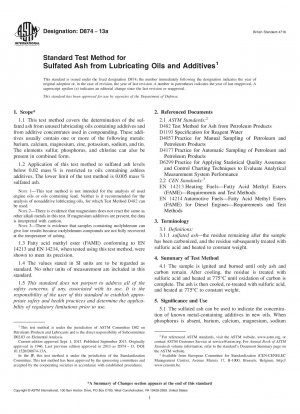ASTM D874-13a
Standard Test Method for Sulfated Ash from Lubricating Oils and Additives
- Standard No.
- ASTM D874-13a
- Release Date
- 2013
- Published By
- American Society for Testing and Materials (ASTM)
- Status
- Replace By
- ASTM D874-13a(2018)
- Latest
- ASTM D874-23
- Scope
5.1 The sulfated ash can be used to indicate the concentration of known metal-containing additives in new oils. When phosphorus is absent, barium, calcium, magnesium, sodium and potassium are converted to their sulfates and tin (stannic) and zinc to their oxides (Note 4). Sulfur and chlorine do not interfere, but when phosphorus is present with metals, it remains partially or wholly in the sulfated ash as metal phosphates.
5.2 Because of above inter-element interferences, experimentally obtained sulfated ash values may differ from sulfated ash values calculated from elemental analysis. The formation of such non-sulfated species is dependent on the temperature of ashing, time ashed, and the composition of metal compounds present in oils. Hence, sulfated ash requirement generally should not be used in product specifications without a clear understanding between a buyer and a seller of the unreliability of an ash value as an indicator of the total metallic compound content.4
1.1 This test method covers the determination of the sulfated ash from unused lubricating oils containing additives and from additive concentrates used in compounding. These additives usually contain one or more of the following metals: barium, calcium, magnesium, zinc, potassium, sodium, and tin. The elements sulfur, phosphorus, and chlorine can also be present in combined form.
1.2 Application of this test method to sulfated ash levels below 0.02 mass8201;% is restricted to oils containing ashless additives. The lower limit of the test method is 0.005 mass8201;% sulfated ash.
Note 1—This test method is not intended for the analysis of used engine oils or oils containing lead. Neither is it recommended for the analysis of nonadditive lubricating oils, for which Test Method D482 can be used.1.3 Fatty acid methyl ester (FAME) conforming to EN 14213 and EN 14214, when tested using this test method, were shown to meet its precision.
1.4 The values stated in SI units are to be regarded as standard.......
ASTM D874-13a Referenced Document
- ASTM D1193 Standard Specification for Reagent Water
- ASTM D4057 Standard Practice for Manual Sampling of Petroleum and Petroleum Products
- ASTM D4177 Standard Practice for Automatic Sampling of Petroleum and Petroleum Products
- ASTM D482 Standard Test Method for Ash from Petroleum Products
- ASTM D6299 Standard Practice for Applying Statistical Quality Assurance and Control Charting Techniques to Evaluate Analytical Measurement System Performance
ASTM D874-13a history
- 2023 ASTM D874-23 Standard Test Method for Sulfated Ash from Lubricating Oils and Additives
- 2018 ASTM D874-13a(2018) Standard Test Method for Sulfated Ash from Lubricating Oils and Additives
- 2013 ASTM D874-13a Standard Test Method for Sulfated Ash from Lubricating Oils and Additives
- 2013 ASTM D874-13 Standard Test Method for Sulfated Ash from Lubricating Oils and Additives
- 2007 ASTM D874-07 Standard Test Method for Sulfated Ash from Lubricating Oils and Additives
- 2006 ASTM D874-06 Standard Test Method for Sulfated Ash from Lubricating Oils and Additives
- 2000 ASTM D874-00 Standard Test Method for Sulfated Ash from Lubricating Oils and Additives

Copyright ©2024 All Rights Reserved